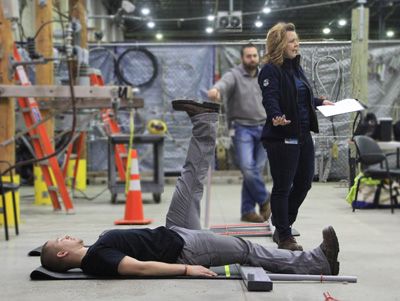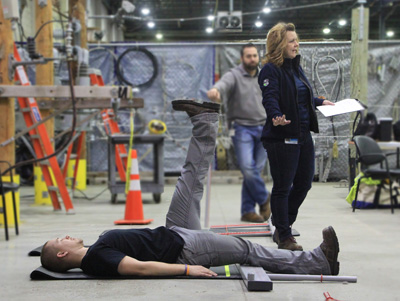
Strength and Conditioning Strategies to Prepare the Next-Generation Utility Worker

Apprenticeships in the utility and construction fields often serve as a transition point for individuals from sedentary or light work to heavy or very heavy jobs. As more individuals seek jobs in the trades, many may have little to no experience with regular physical activity. Injury-free performance of heavy or very heavy job tasks strongly corresponds to an individual’s physical abilities and health habits. While the electrical utility industry strives to engineer the risk out of jobs, many tasks still require a minimum amount of strength, endurance and flexibility.
Strength and conditioning principles have long been used in sports to ensure that would-be players achieve the specific demands of their desired position while also optimizing performance. Similarly, hiring managers, training specialists and safety professionals can implement these same principles into apprenticeships to enable new employees to achieve the physical ability needed to perform their work safely. This creates a win-win scenario that helps to prevent workplace injuries and increase the health and wellness of employees.
Physical Demands Analysis
The first step is to clearly identify and communicate exactly what is expected of prospective employees. Any good job description includes a physical demands analysis (PDA) – a measurement of the minimum physical demands required to perform essential functions. Several benefits arise from documenting this information, but from a hiring perspective, knowing the physical demands serves two purposes: It helps employers identify individuals who possess sufficient physical abilities to perform essential functions without risk of injury, and it helps prospective employees create and work toward a goal.
Generalized Health Profile of Applicants
The second step in the process is to assess the needs of applicants. According to the U.S. Bureau of Labor Statistics, 25- to 34-year-olds account for over half of those seeking employment, while 18- to 24-year-olds account for just under a third. Two useful resources for understanding the general needs of this population group are the Youth Risk Behavior Surveillance System (www.cdc.gov/healthyyouth/data/yrbs/index.htm) and the U.S. Census Bureau (www.census.gov).
In 2017, the Youth Risk Behavior Surveillance System noted a long-term net positive change in tobacco use (decrease) and strengthening activities (increase). However, the report also noted a long-term net negative change when it comes to eating fruits and vegetables (decrease); eating breakfast consistently (decrease); watching TV/playing video games (increase); performing regular physical activity (decrease); getting eight hours of sleep each night (decrease); and prevalence of above-healthy weight (increase). Furthermore, the 2010 U.S. Census found that 62.4% of 18- to 44-year-olds were above healthy weight. Therefore, we can presume that the average job applicant will be slightly above healthy weight; will work out but not do cardio; and will not smoke but will have poor nutritional and sleep habits.
Post-Offer, Pre-Placement Screening
The next step is the post-offer, pre-placement screening (POPPS). The POPPS is the practical application of the PDA. Once a conditional offer of employment is made, a health-care professional (typically third-party) ensures the applicant is healthy enough for physical activity and can safely perform the essential functions of the job.
Fitness and Movement Assessments
Fitness and movement assessments, though not a part of determining employment, help instill a continued focus on physical health and wellness. Fitness assessments provide a practical baseline of strength and aerobic capacity for the individual. Movement screening provides a baseline of how well an individual moves through a functional range. Studies have found that individuals who fall into high-risk categories are significantly more likely to suffer an injury when involved in regular strenuous physical activity.
Conditioning Program
Once physical ability, fitness and movement baselines have been established, the next step is to encourage participation in a conditioning program. For the best outcome, conditioning programs must be tailored toward the functional activities identified in the PDA. After comparing an individual’s assessment results to national norms and the PDA, an exercise-science professional can develop an appropriate program.
Hiring managers should give the conditioning program to those apprentices who have met the physical abilities requirement as a tool to help optimize their performance. Hiring managers also can give the conditioning program to those individuals who did not meet the physical abilities requirements but who are interested in improving areas of weakness and wish to pursue the job at a future point. Regardless to whom the conditioning program is given, it should be provided with enough time for the body to adapt to the change in activity level – at least four to six weeks prior – to help optimize injury prevention benefits.
Nutrition
Most applicants in the U.S. will have some poor nutritional habits, such as not eating enough fruits and vegetables, and not eating breakfast consistently. Proper nutritional counseling should coincide with the conditioning program. Prospective employees should be encouraged to eat appropriate amounts of protein, fats and carbohydrates that fulfill their nutritional needs based on age, gender and activity level.
A Culture of Health and Wellness
The last phase of implementing strength and conditioning principles is promoting a culture of health and wellness once an applicant is hired. Though several causes contribute to the prevalence of injuries among new workers, injury-free performance is promoted by designing apprenticeship programs that offer proper physical conditioning, nutritional education and motor learning principles as key components. Following are more in-depth descriptions of some of these key components.
Warming Up
Both warming up and stretching are needed to avoid and recover from muscular injury. Current recommendations support warming up for the first 10 to 15 minutes of activity. A good determinant for “warmed up” is when the body begins producing a light sweat and both heart rate and breathing rate are slightly elevated. Stretching should be performed for a cumulative of at least two minutes per body part per week to aid in muscle recovery.
Activity Progression
Activity progression should only occur once a foundational skill is mastered (i.e., an individual can perform a task safely, proficiently and without fatigue). Once a foundational skill is mastered, volume (duration, repetition and intensity) should be increased by approximately 10% between training sessions.
Recovery Periods
Adequate recovery periods following strenuous physical activity promote strength gains, enhance recovery and decrease fatigue. For strenuous activity, recovery periods for untrained individuals should last two to three times as long as it took to perform the task. The recovery-to-work ratio should not decrease below 1:1.
Sleep is another important component of recovery that often is overlooked. New employees should understand that sleep not only allows the body to heal, but it also affords the brain the time to process and store new information, allowing for better recall.
Motor Skill Sequencing
Proper motor skill sequencing contributes greatly to enabling injury-free and error-free job performance. This often presents a challenge when employees possess the physical ability but not yet the cognitive ability to perform a task. In order to learn a new task, the brain follows a complex process of converting sensory information into performance. Any disruption in the process (e.g., attention lapse, forgetting, inadequate feedback, personality) can result in performance error or injury. Instruction should be given in a manner that facilitates attention, rehearsal and feedback, and accommodates personality. This type of education promotes a shift to quality of performance rather than quantity.
Nutritional Counseling
Proper nutritional counseling should continue throughout the apprenticeship. Employees should be encouraged to eat several times during the day, including a recovery snack immediately following strenuous physical activity. Employees should drink water when thirsty and consume low-carbohydrate electrolyte beverages when engaged in strenuous activity, especially in hot and humid environments.
Environmental Considerations
Occasionally, an apprenticeship will coincide with challenging environmental conditions. Workers performing physical activity in hot, humid environments, especially in direct sun, have high potential for suffering exertional heat illness. Likewise, workers performing physical activity in cold, wet and windy environments have high potential for contracting cold-related illnesses. Preventing these types of illnesses involves measuring the effective environmental conditions and curtailing, or even suspending, strenuous physical activity during high-risk periods.
Conclusion
Applying strength and conditioning principles to the hiring environment empowers newly hired employees to safely perform work. Many applicants bring with them poor health habits that inhibit an injury-free transition from sedentary or light work to heavy or very heavy work. Apprenticeships in the utility and construction fields that provide baseline assessments, conditioning, nutritional coaching and intentionally paced physical skills sessions enable an injury-free environment. Before making any changes to your program, it is strongly advised to collaborate with professionals in law, human resources, health care, exercise science and instructional design.
About the Author: Jeremy Verrillo, ATC, CEAS III, CWcHP, CMMSS, is a founding partner of CIP Solutions Inc. (www.cipsolutionsinc.com), a health, wellness and ergonomics consulting firm. A graduate of West Chester University’s athletic training program, Verrillo has been working with the specific needs of the utility and construction sectors since 2003.

